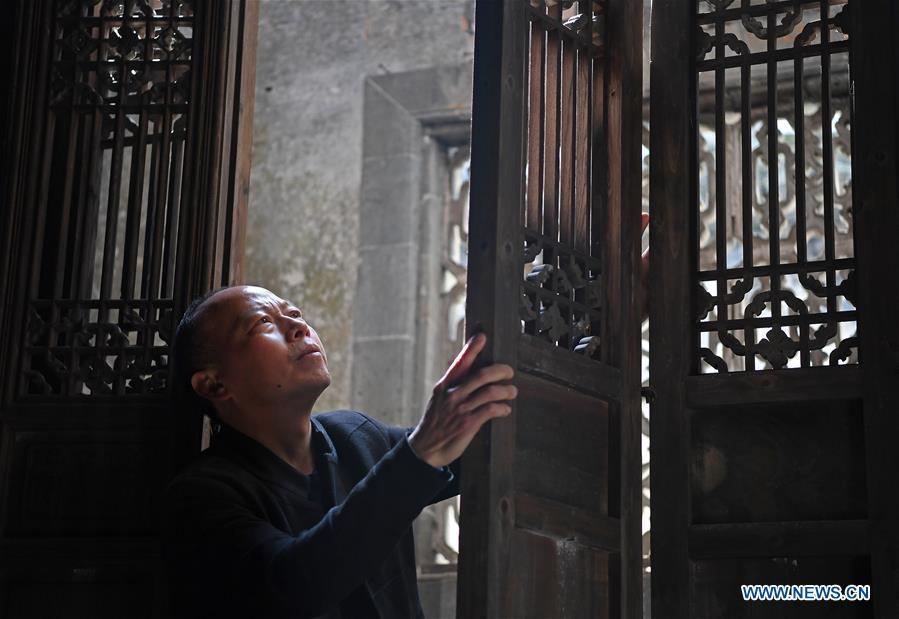
Yu Youhong checks a part of an ancient building in Wangkou Village, Wuyuan County of east China's Jiangxi Province, March 19, 2019. The "Three Carvings in Wuyuan", including carvings on stones, bricks and wood, was listed as one of China's national intangible cultural heritages in 2006. As decorating carvings on buildings during ancient Ming and Qing dynasties in Wuyuan of east China's Jiangxi, the carvings take materials with high quality and demand high standards of handicraft, displaying the features of local culture. Yu Youhong, a national-level inheritor of the handicraft, has been in the field for more than 30 years. Born in a craftmen family, he became interested in the art as a young man and started to learn carpentry at 16 years old. After five years of industrious study, Yu grasped the basic crafts of the "Three Carvings in Wuyuan". His excellent handicraft can be seen through his work of "Drawing of Emperor's Hunting", which displays 50 plus characters and 30 plus animals on a space of less than 0.33 square meters. The work costs him three years to prepare and boasts ten layers altogether. With ancient buildings and carvings in Wuyuan dilapidating, Yu made up his mind to protect the traditional cultural heritage. Accepting more than 40 apprentices, Yu has completes the restoring of carvings on more than 100 ancient buildings of Ming and Qing dynasties nowadays. He hopes more youngsters can learn the artwork and that the cultural heritage can reborn in the hands of new generations. (Xinhua/Wan Xiang)
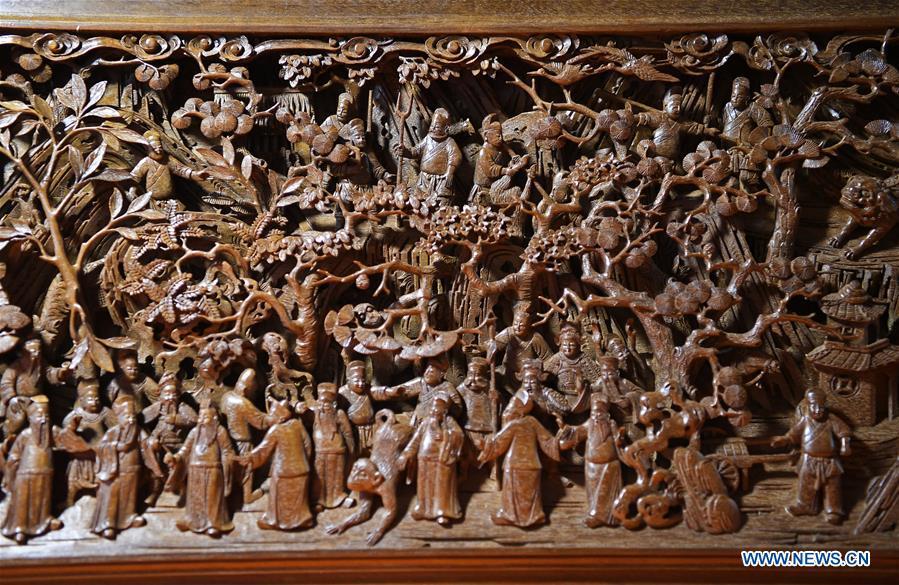
Photo taken on March 18, 2019 shows the details of the artwork "Drawing of Emperor's Hunting" by Yu Youhong. The "Three Carvings in Wuyuan", including carvings on stones, bricks and wood, was listed as one of China's national intangible cultural heritages in 2006. As decorating carvings on buildings during ancient Ming and Qing dynasties in Wuyuan of east China's Jiangxi, the carvings take materials with high quality and demand high standards of handicraft, displaying the features of local culture. Yu Youhong, a national-level inheritor of the handicraft, has been in the field for more than 30 years. Born in a craftmen family, he became interested in the art as a young man and started to learn carpentry at 16 years old. After five years of industrious study, Yu grasped the basic crafts of the "Three Carvings in Wuyuan". His excellent handicraft can be seen through his work of "Drawing of Emperor's Hunting", which displays 50 plus characters and 30 plus animals on a space of less than 0.33 square meters. The work costs him three years to prepare and boasts ten layers altogether. With ancient buildings and carvings in Wuyuan dilapidating, Yu made up his mind to protect the traditional cultural heritage. Accepting more than 40 apprentices, Yu has completes the restoring of carvings on more than 100 ancient buildings of Ming and Qing dynasties nowadays. He hopes more youngsters can learn the artwork and that the cultural heritage can reborn in the hands of new generations. (Xinhua/Wan Xiang)
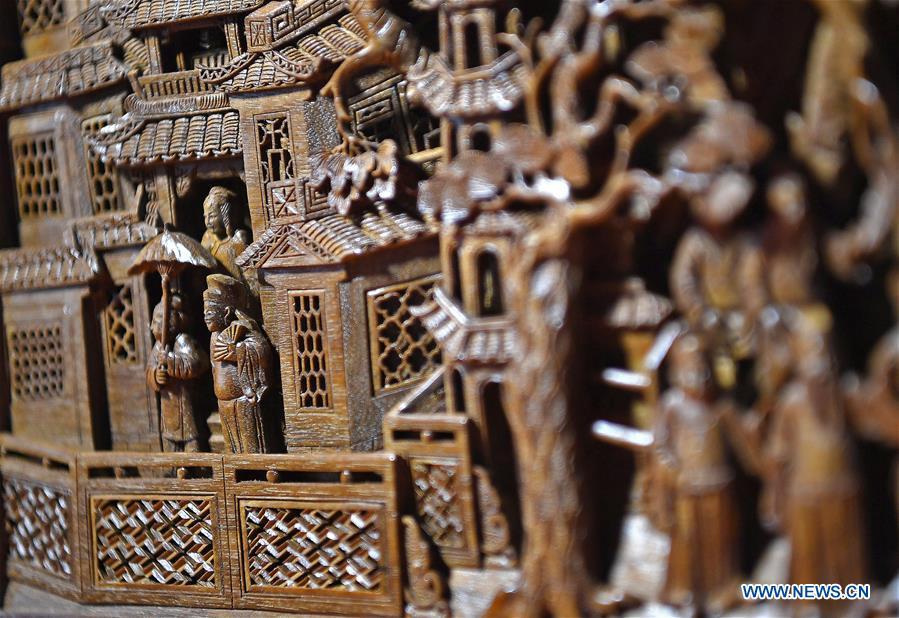
Photo taken on March 18, 2019 shows the details of the artwork "Drawing of Emperor's Hunting" by Yu Youhong. The "Three Carvings in Wuyuan", including carvings on stones, bricks and wood, was listed as one of China's national intangible cultural heritages in 2006. As decorating carvings on buildings during ancient Ming and Qing dynasties in Wuyuan of east China's Jiangxi, the carvings take materials with high quality and demand high standards of handicraft, displaying the features of local culture. Yu Youhong, a national-level inheritor of the handicraft, has been in the field for more than 30 years. Born in a craftmen family, he became interested in the art as a young man and started to learn carpentry at 16 years old. After five years of industrious study, Yu grasped the basic crafts of the "Three Carvings in Wuyuan". His excellent handicraft can be seen through his work of "Drawing of Emperor's Hunting", which displays 50 plus characters and 30 plus animals on a space of less than 0.33 square meters. The work costs him three years to prepare and boasts ten layers altogether. With ancient buildings and carvings in Wuyuan dilapidating, Yu made up his mind to protect the traditional cultural heritage. Accepting more than 40 apprentices, Yu has completes the restoring of carvings on more than 100 ancient buildings of Ming and Qing dynasties nowadays. He hopes more youngsters can learn the artwork and that the cultural heritage can reborn in the hands of new generations. (Xinhua/Wan Xiang)
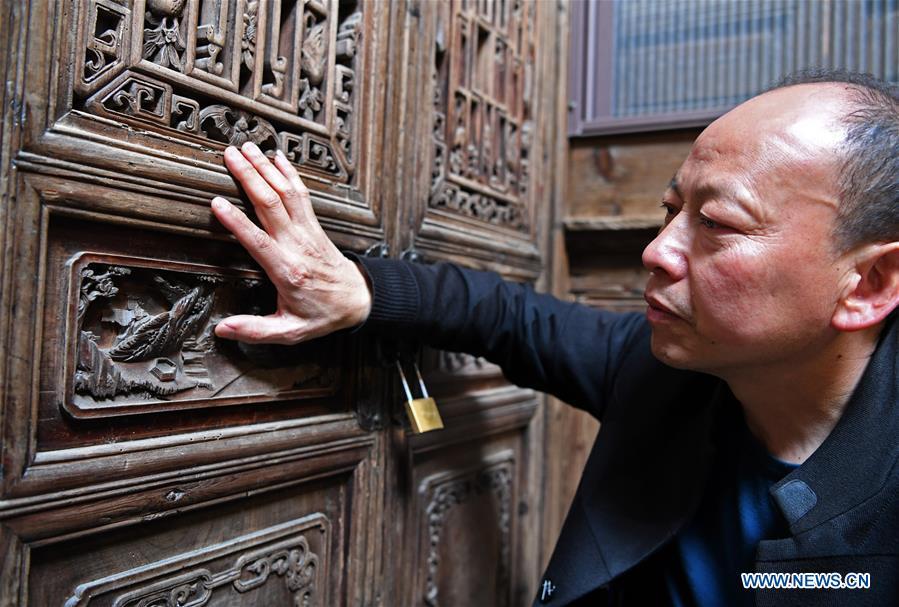
Yu Youhong checks a broken carving work on wood inside an ancient building in Zhangcun Village, Wuyuan County of east China's Jiangxi Province, March 19, 2019. The "Three Carvings in Wuyuan", including carvings on stones, bricks and wood, was listed as one of China's national intangible cultural heritages in 2006. As decorating carvings on buildings during ancient Ming and Qing dynasties in Wuyuan of east China's Jiangxi, the carvings take materials with high quality and demand high standards of handicraft, displaying the features of local culture. Yu Youhong, a national-level inheritor of the handicraft, has been in the field for more than 30 years. Born in a craftmen family, he became interested in the art as a young man and started to learn carpentry at 16 years old. After five years of industrious study, Yu grasped the basic crafts of the "Three Carvings in Wuyuan". His excellent handicraft can be seen through his work of "Drawing of Emperor's Hunting", which displays 50 plus characters and 30 plus animals on a space of less than 0.33 square meters. The work costs him three years to prepare and boasts ten layers altogether. With ancient buildings and carvings in Wuyuan dilapidating, Yu made up his mind to protect the traditional cultural heritage. Accepting more than 40 apprentices, Yu has completes the restoring of carvings on more than 100 ancient buildings of Ming and Qing dynasties nowadays. He hopes more youngsters can learn the artwork and that the cultural heritage can reborn in the hands of new generations. (Xinhua/Wan Xiang)
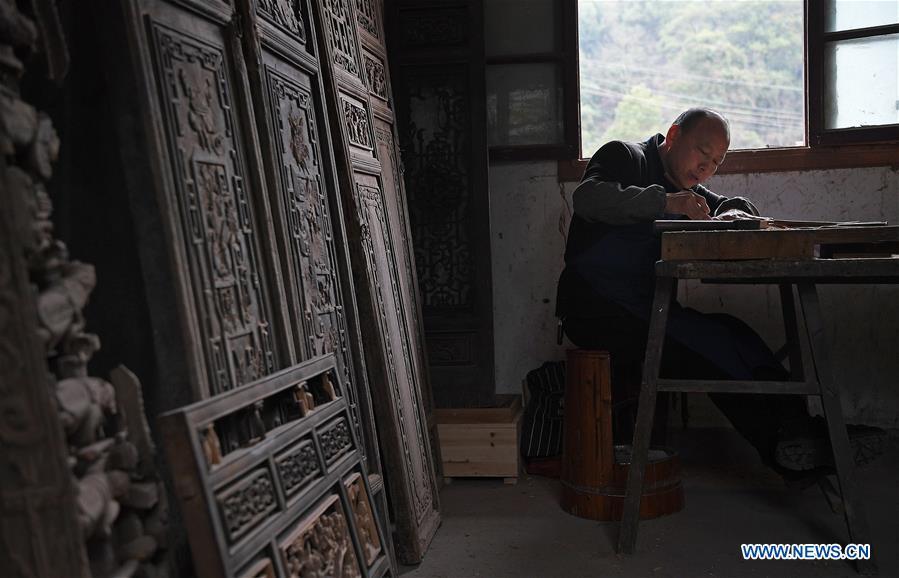
Yu Youhong makes carvings on wood at his studio in Wangkou Village, Wuyuan County of east China's Jiangxi Province, March 18, 2019. The "Three Carvings in Wuyuan", including carvings on stones, bricks and wood, was listed as one of China's national intangible cultural heritages in 2006. As decorating carvings on buildings during ancient Ming and Qing dynasties in Wuyuan of east China's Jiangxi, the carvings take materials with high quality and demand high standards of handicraft, displaying the features of local culture. Yu Youhong, a national-level inheritor of the handicraft, has been in the field for more than 30 years. Born in a craftmen family, he became interested in the art as a young man and started to learn carpentry at 16 years old. After five years of industrious study, Yu grasped the basic crafts of the "Three Carvings in Wuyuan". His excellent handicraft can be seen through his work of "Drawing of Emperor's Hunting", which displays 50 plus characters and 30 plus animals on a space of less than 0.33 square meters. The work costs him three years to prepare and boasts ten layers altogether. With ancient buildings and carvings in Wuyuan dilapidating, Yu made up his mind to protect the traditional cultural heritage. Accepting more than 40 apprentices, Yu has completes the restoring of carvings on more than 100 ancient buildings of Ming and Qing dynasties nowadays. He hopes more youngsters can learn the artwork and that the cultural heritage can reborn in the hands of new generations. (Xinhua/Wan Xiang)
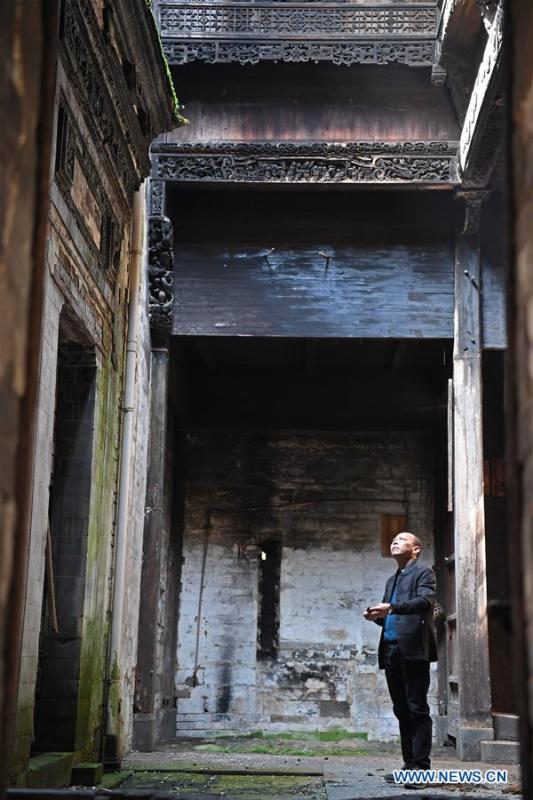
Yu Youhong checks a dilapidated ancient building in Wangkou Village, Wuyuan County of east China's Jiangxi Province, March 19, 2019. The "Three Carvings in Wuyuan", including carvings on stones, bricks and wood, was listed as one of China's national intangible cultural heritages in 2006. As decorating carvings on buildings during ancient Ming and Qing dynasties in Wuyuan of east China's Jiangxi, the carvings take materials with high quality and demand high standards of handicraft, displaying the features of local culture. Yu Youhong, a national-level inheritor of the handicraft, has been in the field for more than 30 years. Born in a craftmen family, he became interested in the art as a young man and started to learn carpentry at 16 years old. After five years of industrious study, Yu grasped the basic crafts of the "Three Carvings in Wuyuan". His excellent handicraft can be seen through his work of "Drawing of Emperor's Hunting", which displays 50 plus characters and 30 plus animals on a space of less than 0.33 square meters. The work costs him three years to prepare and boasts ten layers altogether. With ancient buildings and carvings in Wuyuan dilapidating, Yu made up his mind to protect the traditional cultural heritage. Accepting more than 40 apprentices, Yu has completes the restoring of carvings on more than 100 ancient buildings of Ming and Qing dynasties nowadays. He hopes more youngsters can learn the artwork and that the cultural heritage can reborn in the hands of new generations. (Xinhua/Wan Xiang)
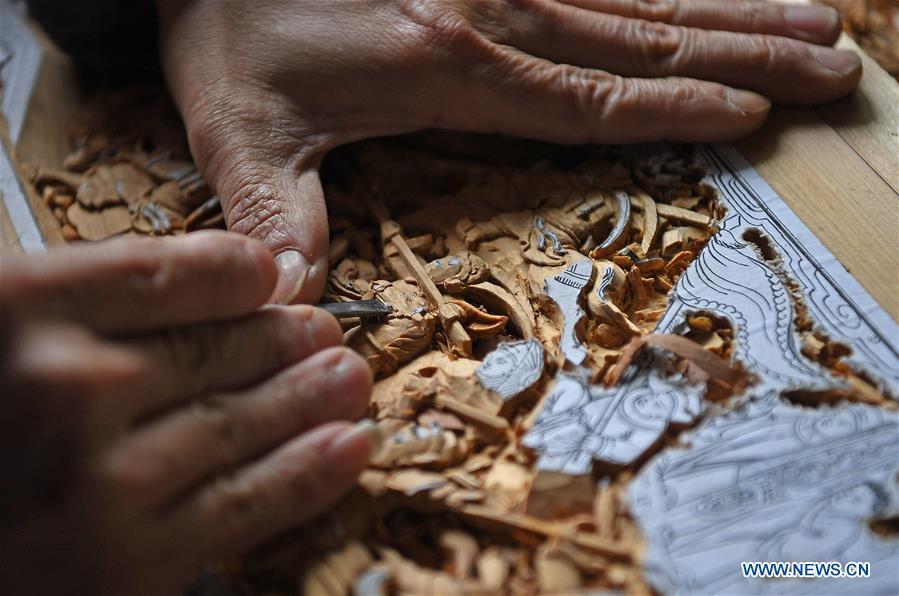
Yu Youhong makes carvings on wood at his studio in Wangkou Village, Wuyuan County of east China's Jiangxi Province, March 18, 2019. The "Three Carvings in Wuyuan", including carvings on stones, bricks and wood, was listed as one of China's national intangible cultural heritages in 2006. As decorating carvings on buildings during ancient Ming and Qing dynasties in Wuyuan of east China's Jiangxi, the carvings take materials with high quality and demand high standards of handicraft, displaying the features of local culture. Yu Youhong, a national-level inheritor of the handicraft, has been in the field for more than 30 years. Born in a craftmen family, he became interested in the art as a young man and started to learn carpentry at 16 years old. After five years of industrious study, Yu grasped the basic crafts of the "Three Carvings in Wuyuan". His excellent handicraft can be seen through his work of "Drawing of Emperor's Hunting", which displays 50 plus characters and 30 plus animals on a space of less than 0.33 square meters. The work costs him three years to prepare and boasts ten layers altogether. With ancient buildings and carvings in Wuyuan dilapidating, Yu made up his mind to protect the traditional cultural heritage. Accepting more than 40 apprentices, Yu has completes the restoring of carvings on more than 100 ancient buildings of Ming and Qing dynasties nowadays. He hopes more youngsters can learn the artwork and that the cultural heritage can reborn in the hands of new generations. (Xinhua/Wan Xiang)
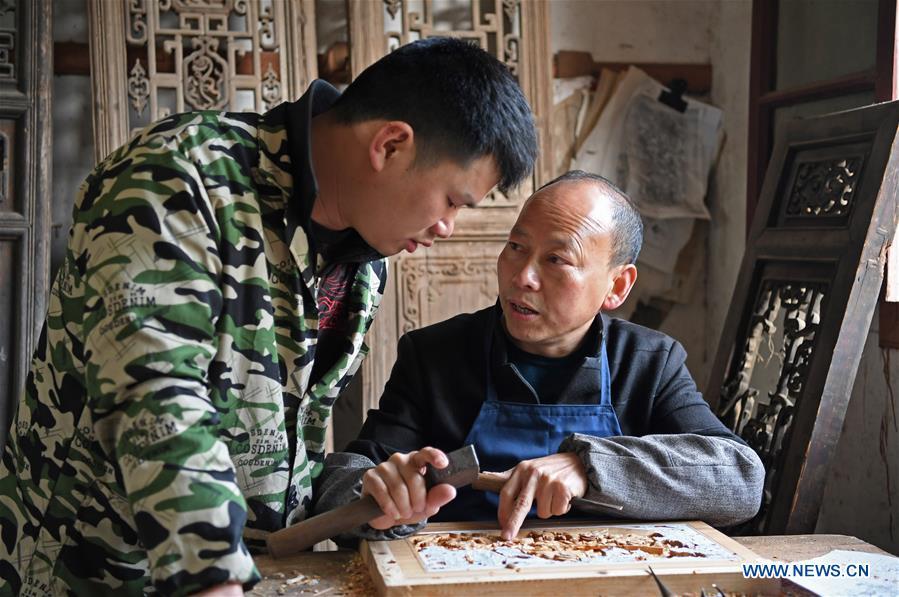
Yu Youhong teaches his apprentice the techniques on carvings in Wuyuan County of east China's Jiangxi Province, March 19, 2019. The "Three Carvings in Wuyuan", including carvings on stones, bricks and wood, was listed as one of China's national intangible cultural heritages in 2006. As decorating carvings on buildings during ancient Ming and Qing dynasties in Wuyuan of east China's Jiangxi, the carvings take materials with high quality and demand high standards of handicraft, displaying the features of local culture. Yu Youhong, a national-level inheritor of the handicraft, has been in the field for more than 30 years. Born in a craftmen family, he became interested in the art as a young man and started to learn carpentry at 16 years old. After five years of industrious study, Yu grasped the basic crafts of the "Three Carvings in Wuyuan". His excellent handicraft can be seen through his work of "Drawing of Emperor's Hunting", which displays 50 plus characters and 30 plus animals on a space of less than 0.33 square meters. The work costs him three years to prepare and boasts ten layers altogether. With ancient buildings and carvings in Wuyuan dilapidating, Yu made up his mind to protect the traditional cultural heritage. Accepting more than 40 apprentices, Yu has completes the restoring of carvings on more than 100 ancient buildings of Ming and Qing dynasties nowadays. He hopes more youngsters can learn the artwork and that the cultural heritage can reborn in the hands of new generations. (Xinhua/Wan Xiang)
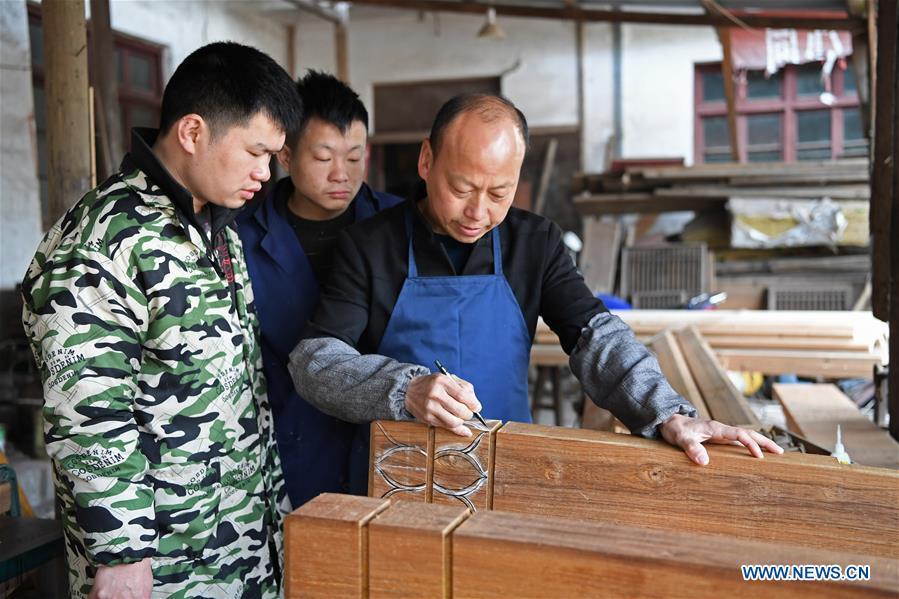
Yu Youhong teaches his apprentices the techniques on carvings in Wuyuan County of east China's Jiangxi Province, March 19, 2019. The "Three Carvings in Wuyuan", including carvings on stones, bricks and wood, was listed as one of China's national intangible cultural heritages in 2006. As decorating carvings on buildings during ancient Ming and Qing dynasties in Wuyuan of east China's Jiangxi, the carvings take materials with high quality and demand high standards of handicraft, displaying the features of local culture. Yu Youhong, a national-level inheritor of the handicraft, has been in the field for more than 30 years. Born in a craftmen family, he became interested in the art as a young man and started to learn carpentry at 16 years old. After five years of industrious study, Yu grasped the basic crafts of the "Three Carvings in Wuyuan". His excellent handicraft can be seen through his work of "Drawing of Emperor's Hunting", which displays 50 plus characters and 30 plus animals on a space of less than 0.33 square meters. The work costs him three years to prepare and boasts ten layers altogether. With ancient buildings and carvings in Wuyuan dilapidating, Yu made up his mind to protect the traditional cultural heritage. Accepting more than 40 apprentices, Yu has completes the restoring of carvings on more than 100 ancient buildings of Ming and Qing dynasties nowadays. He hopes more youngsters can learn the artwork and that the cultural heritage can reborn in the hands of new generations. (Xinhua/Wan Xiang)
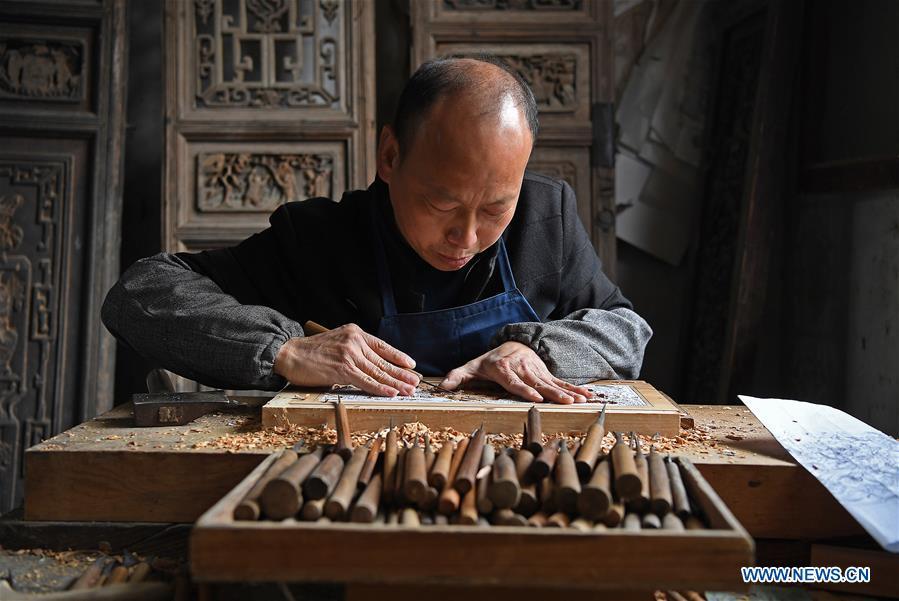
Yu Youhong makes carvings on wood at his studio in Wangkou Village, Wuyuan County of east China's Jiangxi Province, March 18, 2019. The "Three Carvings in Wuyuan", including carvings on stones, bricks and wood, was listed as one of China's national intangible cultural heritages in 2006. As decorating carvings on buildings during ancient Ming and Qing dynasties in Wuyuan of east China's Jiangxi, the carvings take materials with high quality and demand high standards of handicraft, displaying the features of local culture. Yu Youhong, a national-level inheritor of the handicraft, has been in the field for more than 30 years. Born in a craftmen family, he became interested in the art as a young man and started to learn carpentry at 16 years old. After five years of industrious study, Yu grasped the basic crafts of the "Three Carvings in Wuyuan". His excellent handicraft can be seen through his work of "Drawing of Emperor's Hunting", which displays 50 plus characters and 30 plus animals on a space of less than 0.33 square meters. The work costs him three years to prepare and boasts ten layers altogether. With ancient buildings and carvings in Wuyuan dilapidating, Yu made up his mind to protect the traditional cultural heritage. Accepting more than 40 apprentices, Yu has completes the restoring of carvings on more than 100 ancient buildings of Ming and Qing dynasties nowadays. He hopes more youngsters can learn the artwork and that the cultural heritage can reborn in the hands of new generations. (Xinhua/Wan Xiang)
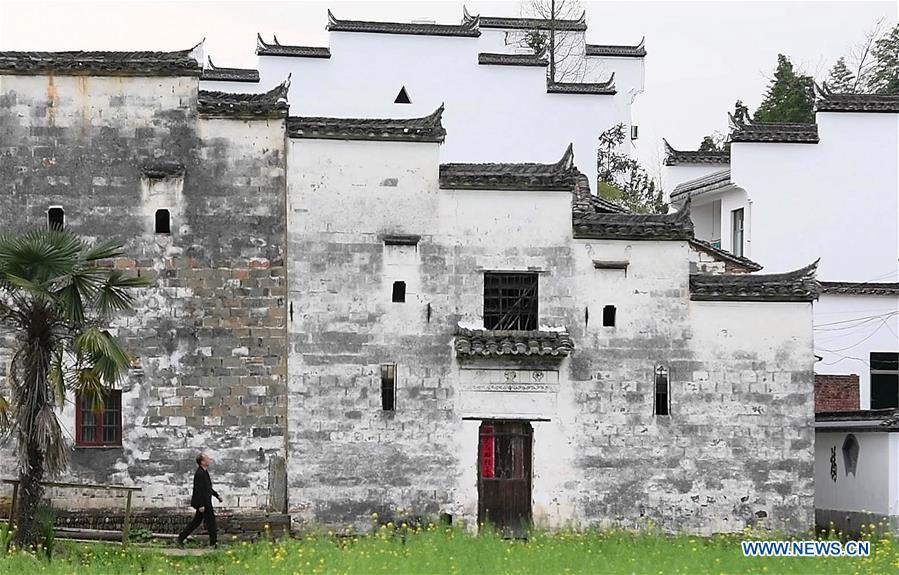
Yu Youhong walks past an ancient building in Zhangcun Village, Wuyuan County of east China's Jiangxi Province, March 19, 2019. The "Three Carvings in Wuyuan", including carvings on stones, bricks and wood, was listed as one of China's national intangible cultural heritages in 2006. As decorating carvings on buildings during ancient Ming and Qing dynasties in Wuyuan of east China's Jiangxi, the carvings take materials with high quality and demand high standards of handicraft, displaying the features of local culture. Yu Youhong, a national-level inheritor of the handicraft, has been in the field for more than 30 years. Born in a craftmen family, he became interested in the art as a young man and started to learn carpentry at 16 years old. After five years of industrious study, Yu grasped the basic crafts of the "Three Carvings in Wuyuan". His excellent handicraft can be seen through his work of "Drawing of Emperor's Hunting", which displays 50 plus characters and 30 plus animals on a space of less than 0.33 square meters. The work costs him three years to prepare and boasts ten layers altogether. With ancient buildings and carvings in Wuyuan dilapidating, Yu made up his mind to protect the traditional cultural heritage. Accepting more than 40 apprentices, Yu has completes the restoring of carvings on more than 100 ancient buildings of Ming and Qing dynasties nowadays. He hopes more youngsters can learn the artwork and that the cultural heritage can reborn in the hands of new generations. (Xinhua/Wan Xiang)
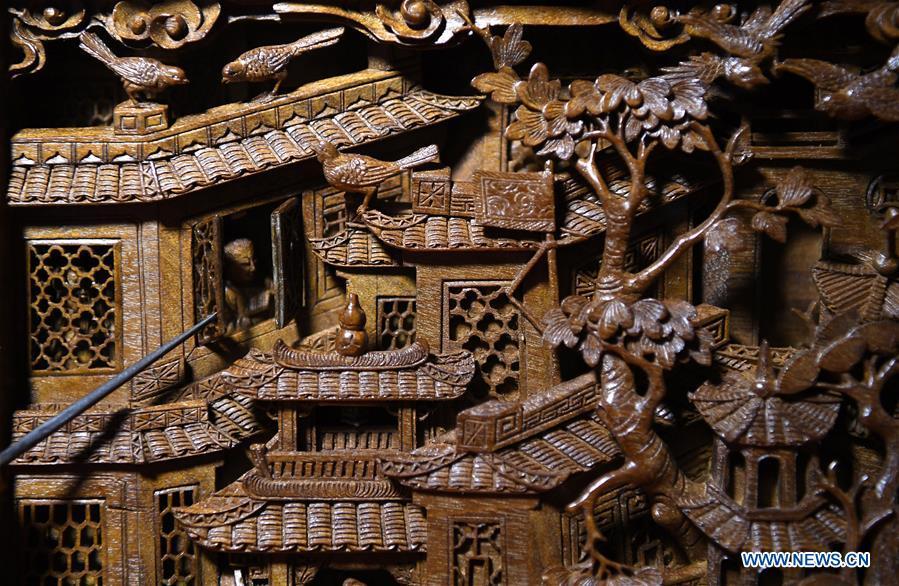
Photo taken on March 18, 2019 shows the details of the artwork "Drawing of Emperor's Hunting" by Yu Youhong. The "Three Carvings in Wuyuan", including carvings on stones, bricks and wood, was listed as one of China's national intangible cultural heritages in 2006. As decorating carvings on buildings during ancient Ming and Qing dynasties in Wuyuan of east China's Jiangxi, the carvings take materials with high quality and demand high standards of handicraft, displaying the features of local culture. Yu Youhong, a national-level inheritor of the handicraft, has been in the field for more than 30 years. Born in a craftmen family, he became interested in the art as a young man and started to learn carpentry at 16 years old. After five years of industrious study, Yu grasped the basic crafts of the "Three Carvings in Wuyuan". His excellent handicraft can be seen through his work of "Drawing of Emperor's Hunting", which displays 50 plus characters and 30 plus animals on a space of less than 0.33 square meters. The work costs him three years to prepare and boasts ten layers altogether. With ancient buildings and carvings in Wuyuan dilapidating, Yu made up his mind to protect the traditional cultural heritage. Accepting more than 40 apprentices, Yu has completes the restoring of carvings on more than 100 ancient buildings of Ming and Qing dynasties nowadays. He hopes more youngsters can learn the artwork and that the cultural heritage can reborn in the hands of new generations. (Xinhua/Wan Xiang)





